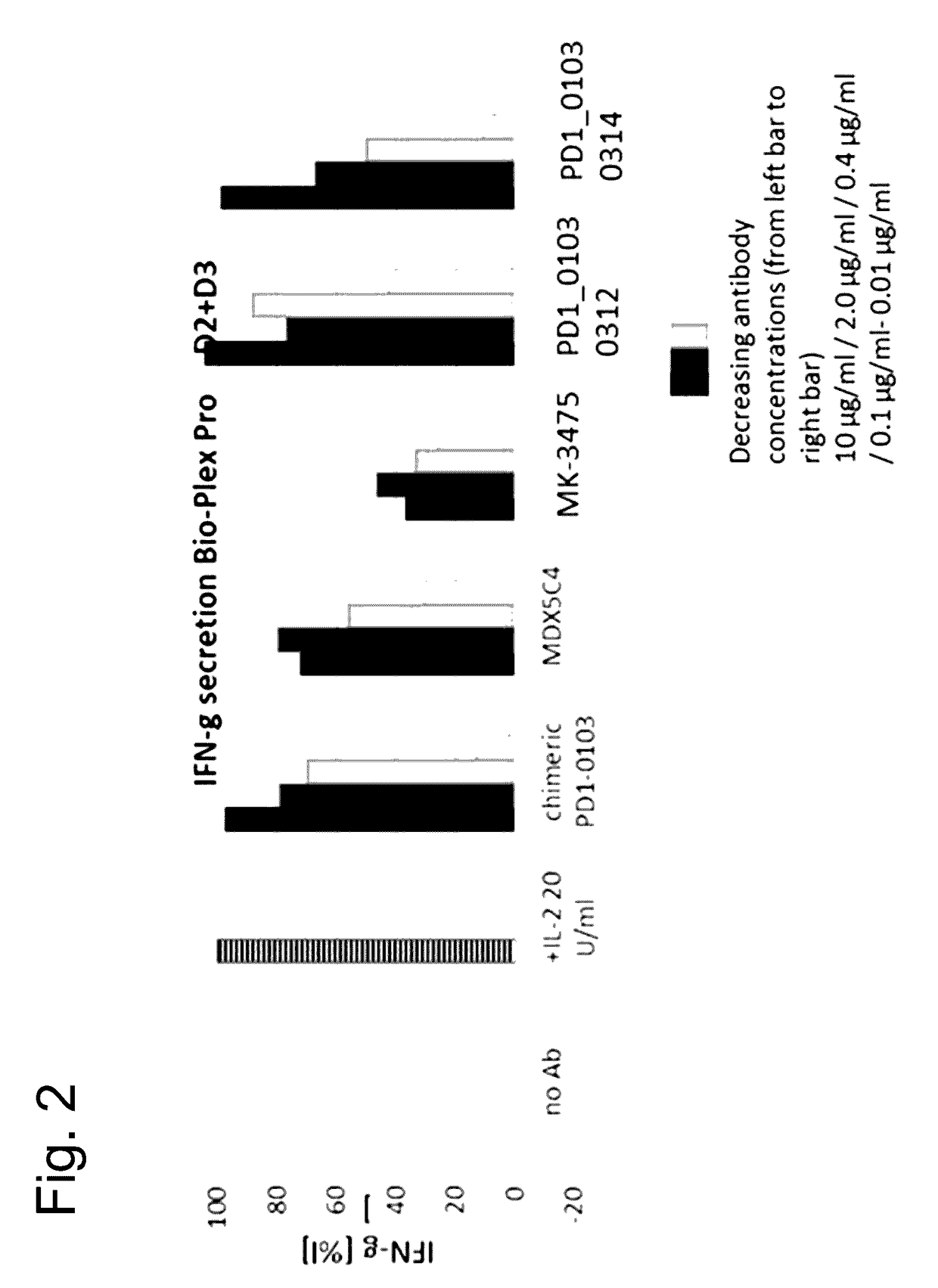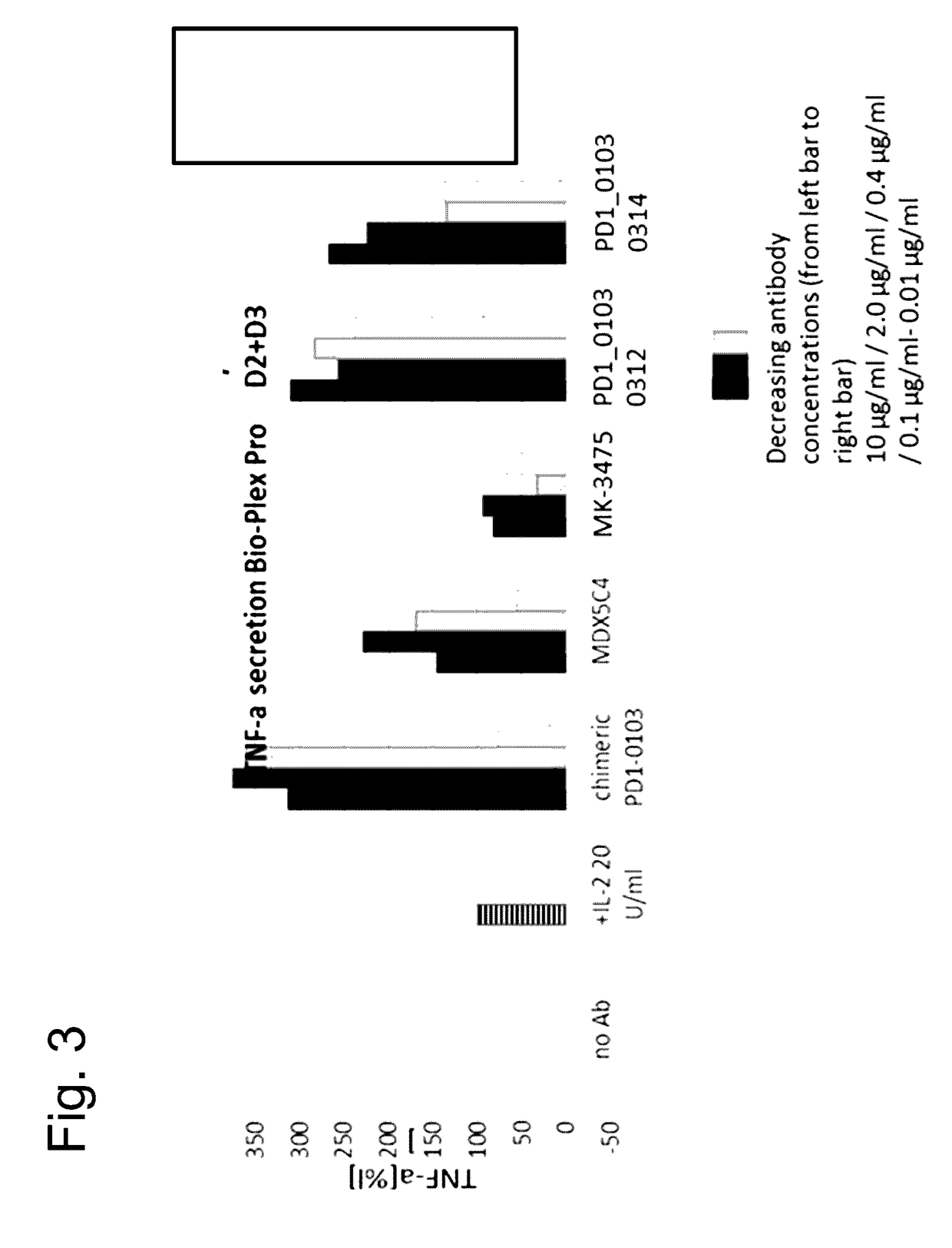Bispecific antibodies specific for pd1 and tim3
a technology of pd1 and tim3, which is applied in the field of bispecific antibodies, can solve the problems of increased infections and mortality, tumor evasion, and persistence of viral infections, and achieve the effect of reducing binding
- Summary
- Abstract
- Description
- Claims
- Application Information
AI Technical Summary
Benefits of technology
Problems solved by technology
Method used
Image
Examples
example 1a
of Anti-TIM3 Antibodies
Immunization of Mice
[0782]NMRI mice were immunized genetically, using a plasmid expression vector coding for full-length human Tim-3 by intradermal application of 100 ug vector DNA (plasmid 15304_hTIM3-fl), followed by Electroporation (2 square pulses of 1000 V / cm, duration 0.1 ms, interval 0.125 s; followed by 4 square pulses of 287.5 V / cm, duration 10 ms, interval 0.125 s. Mice received either 6 consecutive immunizations at days 0, 14, 28, 42, 56, 70, and 84. Blood was taken at days 36, 78 and 92 and serum prepared, which was used for titer determination by ELISA (see below). Animals with highest titers were selected for boosting at day 96, by intravenous injection of 50 ug of recombinant human Tim-3 human Fc chimera, and monoclonal antibodies were isolated by hybridoma technology, by fusion of splenocytes to myeloma cell line 3 days after boost.
Determination of Serum Titers (ELISA)
[0783]Human recombinant Tim-3 human Fc chimera was immobilized on a 96-well N...
example 1b
zation Anti-TIM3 Antibodies
ELISA for TIM3
[0784]Nunc-Maxi Sorp Streptavidine plates (MicroCoat #11974998 / MC1099) were coated by 25 μl / well with Tim3-ECD-His-Biotin (biotinylated with BirA Ligase) and incubated at RT for 1 h while shaking at 400 rpm rotation. After washing (3×90 μl / well with PBST-buffer) 25 μl aTim3 samples or diluted (1:2 steps) reference antibody aTim3 F38-2E2 (Biolegend) was added and incubated 1 h at RT. After washing (3×90 with PBST-buffer) 25 μl / well sheep-anti-mouse-POD (GE NA9310V) was added in 1:9000 dilution and incubated at RT for 1 h while shaking at 400 rpm rotation. After washing (4×90 μl / well with PBST-buffer) 25 μl / well TMB substrate (Calbiochem, #CL07) was added and incubated until OD 1.5-2.5. Then the reaction was stopped by addition of 25 μl / well 1N HCL-solution. Measurement took place at 370 / 492 nm.
[0785]ELISA results are listed as EC50-values [ng / ml] in Summary Table 1 below.
Cell ELISA for TIM3
[0786]Adherent CHO-K1 cell line stably transfected wit...
example 2
n of Anti-TIM3 Antibody Derivatives
Chimeric Antibody Derivatives
[0804]Chimeric Tim3 antibodies were generated by amplifying the variable heavy and light chain regions of the anti-TIM3 mouse antibodies Tim3-0016, Tim3-0016 variant (0018), Tim3-0021, Tim3-0022, Tim3-0026, Tim3-0028, Tim3-0030, and Tim3-0033, Tim3-0038 from via PCR and cloning them into heavy chain expression vectors as fusion proteins with human IgG1 backbones / human CH1-Hinge-CH2-CH3 with LALA and PG mutations (Leucine 234 to Alanine, Leucine 235 to Alanine, Proline 329 to Glycine) abrogating effector functions and light chain expression vectors as fusion proteins to human C-kappa. LC and HC Plasmids were then cotransfected into HEK293 and purified after 7 days from supernatants by standard methods for antibody purification.
Removal of Glycosylation Site NYT: Modifying 1 HVR-L1 Position in Tim3-0016, Tim3_0016 Variant (Named 0018 or Tim3_0018) by Substitution of N by Q or S
[0805]Mutations within the variable light chai...
PUM
| Property | Measurement | Unit |
|---|---|---|
| Fraction | aaaaa | aaaaa |
| Volume | aaaaa | aaaaa |
| Volume | aaaaa | aaaaa |
Abstract
Description
Claims
Application Information
 Login to View More
Login to View More - R&D
- Intellectual Property
- Life Sciences
- Materials
- Tech Scout
- Unparalleled Data Quality
- Higher Quality Content
- 60% Fewer Hallucinations
Browse by: Latest US Patents, China's latest patents, Technical Efficacy Thesaurus, Application Domain, Technology Topic, Popular Technical Reports.
© 2025 PatSnap. All rights reserved.Legal|Privacy policy|Modern Slavery Act Transparency Statement|Sitemap|About US| Contact US: help@patsnap.com



